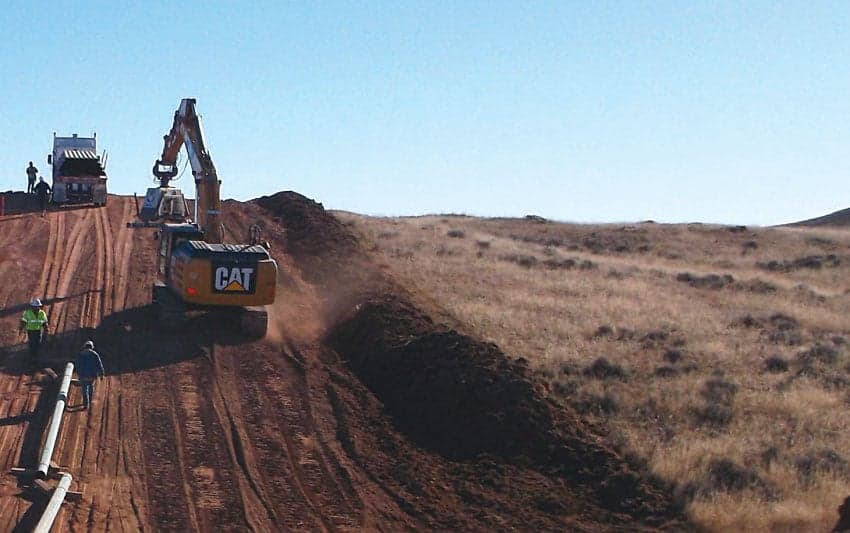A network of pipeline is spreading in Wyoming as energy companies prepare for the next boom.
Since September 2018, hundreds of pipeliners have been out in Wyoming's Powder River Basin laying down the network of line necessary to carry the region's crude and natural gas to market.
As the price of crude fell, they worked through the bitter Wyoming winter and are now trudging through a wet spring to finish projects. But talk is of the boom to come, the increase in traffic and the pipe going in the ground. The only thing holding back the Powder is the price of crude. That, and maybe the amount of pipe in the ground.
Tad True is the vice president of the Belle Fourche and Bridger pipelines, part of his family’s large oil and gas presence in Wyoming and the West. His phone started ringing about two years ago with companies wanting new pipelines in the Powder, he told local news outlet the Casper Star-Tribune.
The price of crude was rising, the political climate for oil was favorable and the Powder — an oil play that was the next big thing before the price soured in 2015, was getting attention again.
From True’s perspective, the growing opportunities in the Powder River Basin may hinge on the speed of infrastructure being laid to take Wyoming oil to market.
Drilling has changed significantly in recent years. Wells being drilled in the Powder are producing higher volumes than they used to. A good well in the past may have had an initial production rate of 200 barrels a day. A well pad in the PRB today might produce 1,500 barrels of oil a day.
And the effect is cumulative as drilling continues in the basin. As soon as one well is finished and brought online, another is nearing completion just over the hill. And then another.
Two years ago, 120 wells were spudded in Converse County. In 2018, operators spudded another 184.
There are 30,000 applications for permits to drill wells awaiting review in the state of Wyoming, according to the Star-Tribune. Most are permit requests for horizontal wells in the Powder. Though not all of the wells will be drilled, the number represents a record level of interest, revealing companies’ desire to control drilling in the basin.
There are three potential constraints on moving oil, True said: getting the barrel of oil from the well head, piping or trucking it to the closest market — in Wyoming’s case, Guernsey — and then moving it out of the state.
Pipeliners in Wyoming are advancing a proposal that would carry crude out of Guernsey and down to the Gulf Coast. Yet another proposal providing potential relief to the Powder oil takeaway challenge would refashion an existing large gas pipeline that runs from the Bakken in North Dakota to the Midwest into an oil line.
Meritage Midstream CEO Steve Huckaby is more comfortable with existing infrastructure than the oil-focused firms operating in the basin. Meritage is primarily a natural gas pipeline firm.
“I honestly believe we have capacity,” Huckaby told the Star-Tribune.
Not that long ago, coal-bed methane, an industry that is nearly dead today, was booming. The result was a network of low-pressure gas lines in the northern basin to gather coal-bed methane, and then higher quality lines to take compressed volumes of that gas to market.
There are also large gas lines running through the Powder River Basin, carrying Bakken gas to the Midwest.
But even though there is pipe out there, it’s not all in the right place as new drilling explores the breadth of the Powder’s best areas.
The distance of some new wells from existing infrastructure has caused an increase in flaring in the Powder River Basin. State regulators have heard an increasing number of requests for flaring, as operators try to prove that infrastructure investment is worth the cost. The increase in flaring has caught the attention of environmental advocates, who are loath to see more and more gas released into the eastern Wyoming air.
It likely won’t be lack of pipe that holds back the Powder, Huckaby said. If anything, it would be the lack of awareness that the basin is a solid investment.
But with just over 30 rigs in Wyoming compared to hundreds of rigs operating in places like the Permian, the Powder doesn’t yet get the attention from investors that it deserves, he said.
“Right now, the biggest challenge is inside the investment community’s head,” he said. “If we really want the Powder River to take off, the number of rigs needs to come up. Investors need to start seeing that and building their own confidence that this basin is real.”
For True, the Powder is ready to boom. The resource is good and world-class operators are improving the basin’s economics, well by well. “I think the Powder River Basin is going to be a big success story,” he said.
img: Meritage Midstream

